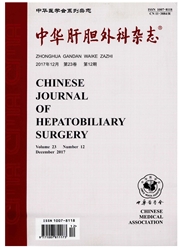

 中文摘要:
中文摘要:
目的探讨膜截流分子量对新型生物人工肝(bioartificialliver,BAL)支持系统免疫安全性的影响。方法应用D氨基半乳糖静脉滴注比格犬建立肝功能衰竭模型。急性肝功能衰竭犬根据BAL隔离膜截流分子量的大小分为两组:A组:200kD组;B组:1200kD组。两组均接受新型2次BAL治疗,每次6h。观察各组体内IgG、IgM、50%补体溶血单位(CH50)变化及反应器内抗体漏过情况。结果在第一次BAL治疗后两组的IgG和IgM水平均没有发生明显的变化。在第2次治疗后第7天,1200kD组的IgG和IgM水平明显升高,200kD组IgG和IgM水平仍未出现明显上升或下降。在第一次BAL治疗后,两组CH50都出现暂时性的下降,在治疗后1h达到最低值,而后缓步上升,在7d后恢复至治疗前水平。反应器内培养液中IgG、IgM及CH50检测结果显示,1200kD组在治疗结束后IgG、IgM及CH50含量显著高于200kD组。结论膜截流分子量可能是影响BAL异种免疫排斥的重要因素之一。
 英文摘要:
英文摘要:
Objective To investigate the influence of membrane molecular weight cut off in our bioartificial liver (BAL) system. Methods Beagle dogs were used for a model of acute liver failure through D-galactosamine administration. The acute liver failure Beagles were divided into two groups by the membrane molecular weight cut off. Group A was treated with BAL containing 200 kDa retention rating membrane. Group B was treated with BAL containing 1200 kDa retention rating membrane. Each group underwent two six-hour BAL treatments that were performed on day 1 and day 21. BAL medium were examined and levels of IgG, IgM, and complement hemolytic unit of 50% (CH50) antibodies were measured in all Beagles and. Results BAL treatment was associated with a significant decline in levels of CH50. 1200 kDa group experienced a significant increase in levels of IgG and IgM after two BAL treatments. Significant levels of canine proteins were detected in BAI. medium from 1200 kDa group. Conclusions Xenogeneic immune response in the BAL system was influenced by membrane molecular weight cut off.
 同期刊论文项目
同期刊论文项目
 同项目期刊论文
同项目期刊论文
 期刊信息
期刊信息
